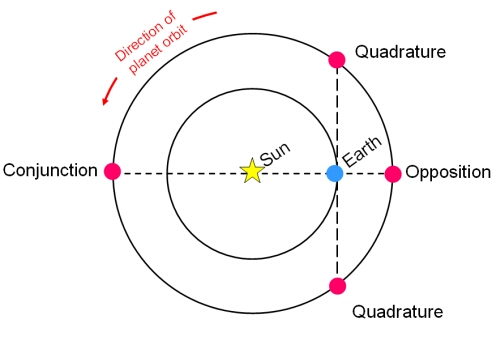THE USM SOUTHWORTH PLANETARIUM
207-780-4249 www.usm.maine.edu/planet
70 Falmouth Street Portland, Maine 04103
43.6667° N 70.2667° W
Altitude: 10 feet below sea level
Altitude: 10 feet below sea level
Founded January 1970
Julian date: 2458644.5
"The coziest home is an untroubled mind."
-Norman Bates
THE DAILY ASTRONOMER
Monday, June 10, 2019
Monday, June 10, 2019
Opposition Research
Imagine at this very moment that you are observing the solar system from what we would inaccurately describe as an "aerial viewpoint." More precisely, imagine you are observing the Sun and its attendant planets from a vantage point perpendicular to the plane of motion. Consequently, you'd see the incandescently bright Sun in the center of a series of concentric planetary orbits. Just for fun, allow each planet to leave a lighted arc in its wake so that it traces out its own orbit as a luminescent ellipse. If you look closely, you will see the minuscule aquamarine Earth gliding between the brilliant Sun and the considerably larger Jupiter. It's happening right about at this moment. We call this moment "opposition," when a planet farther from the Sun than Earth appears opposite the Sun in our sky. This configuration can only occur when our home planet passes between the other planet and the Sun. Jupiter is at opposition today!
That is all very well and, to some, perhaps, intensely interesting. However, one must wonder why such information should be important to astronomers and what it can tell us about Jupiter's visibility.
BRIGHTNESS
First, a planet at opposition will be at its brightest of the year because a superior planet reaches its point of least distance from Earth around this time. In the somewhat exaggerated -and certainly not to scale- graphic below, one can see how much closer a superior planet will be to Earth at opposition than at other points such as quadrature or conjunction. When determining a planet's brightness, distance matters. A planet's brightness relates to its distance from the Sun and its distance from Earth, both of which change continuously. * We know that when a superior planet is approaching opposition, it will tend to grow brighter.

MOTION
Generally, planets appear to move from west to east due to their revolutionary motion around the Sun. However, at times, a planet will appear to become stationary before moving east to west as it moves along "retrograde motion." Superior planets appear to move backward when the faster planet Earth approaches and then passes them along its orbit. This approach and passage can only occur during the time period immediately preceding, during, and immediately following a planetary opposition. Jupiter started its retrograde loop on April 10th. It reaches opposition today, June 10th, and will resume prograde motion on August 11th. One can determine when a planet will be following a retrograde loop by knowing when it is due to be in opposition.
FUTURE POSITION
Jupiter's average synodic period is about 399 days. This means that successive oppositions of Jupiter will occur about every 399 days. The next opposition of Jupiter occurs on July 14, 2020, which is 400 days from today. The synodic period varies slightly because both Earth and Jupiter are always at varying distances from the Sun and therefore do not revolve at constant speeds. We know that Jupiter will be a brilliant summer planet this year as well as the next one and the one following, even if it does reach opposition later in the year in both 2020 and 2021.
Every piece of information pertaining to a planet's orbit is useful to astronomers who want to describe it motion and predict future positions. Knowing when a planet's opposition occurs will help us know when it will be at its brightest, when it will be moving backward and when it will be at opposition in the future.
*The other factors determining a planet's brightness are its albedo (the ratio of reflected to received sunlight) and size. For Saturn, the ring aspect, the ring's angle relative to Earth and the Sun, contributes to the planet's brightness.